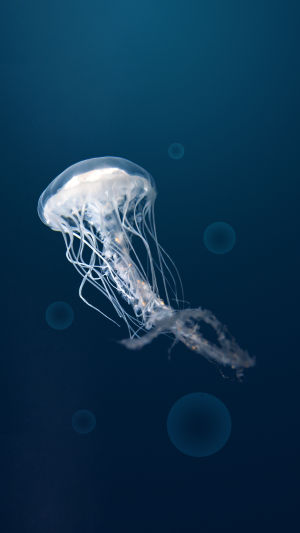The American "World Wildlife" magazine once selected the ten most poisonous animals in the world based on the opinions of scholars worldwide. Among them, the Australian box jellyfish topped the list. Why is the Australian box jellyfish the most poisonous creature in the world?
The Australian box jellyfish mainly live in tropical waters, mostly in the northeastern coastal waters of Australia. They are light blue transparent jellyfish, shaped like a box, with 4 distinct sides, each 20 cm long. These jellyfish are only about 16 inches long.
They have no brains, no hearts, and no bones or muscles. Their bodies are only two-layered structures, like a plastic bag (skin layer) inside another plastic bag (stomach layer), and the two layers are held together by a gel-like glue (mesolayer). More than 95% of these jellyfish are water, and the rest is composed of proteins and lipids.
There are a total of 24 eyes in the box jellyfish, which are distributed in four places. It can be said that there is no dead angle in 360 degrees. A new study by Swedish scientists has found that box jellyfish have developed a set of special human-like eyes that help them make quick 180-degree turns in the ocean and nimbly shuttle between objects.
Box jellyfish propel themselves in the ocean primarily by spraying water from their body cavities. It is even possible for them to change the direction of advancement by changing the position of their bodies cavity opening.
In general, it travels no faster than one section. That is less than 1.85 kilometers per hour, but if frightened, it can travel up to two knots. Their tentacles can't help them swim in the water, but float behind them like thin streamers.
Their eyes are in groups of six, distributed on each face of the tetrahedral umbrella structure, and each group contains a pair of eyes with intricate lens, retinas, iris, and cornea. Different types have different functions, which are divided into 4 types. Some can detect the size of objects, some can distinguish between light and dark, and some can perceive colors.
Scientists still don't know how they process the information their eyes see without a brain.
When the box jellyfish finds its prey, it floats past, entangling it with its tentacles. The Australian box jellyfish has about 5,000 venom-storing stinging cells per tentacle, tiny stinging cells that contain nematocysts that store nematocysts.
When stinging cells are physically stimulated, a small number of stinging cells will release the nematocysts in the nematocysts within a very short period and shoot towards the skin of the contact. The body fluids exuded by the contact after being stabbed in turn stimulate more stinging cells to fire through a chemical reaction.
How sensitive are the stinging cells of box jellyfish? Even inadvertent scratches on shells or skin can irritate these tiny stingers, as well as stimulate the box jellyfish to release the nematocysts in the nematocysts.
After being stabbed, it will cause excruciating and excruciating pain, accompanied by a strong burning sensation, like being scalded by a hot soldering iron. The intense pain can even cause them to drown in shock before going ashore, and even if they survive, the pain can last for weeks, and the skin touched by the tentacles is often markedly scarred.
The venom of the box jellyfish acts directly on the heart, nervous system, and skin cells. When the venom of the box jellyfish invades the human heart, it will destroy the consistency of the beating rhythm of the body cells, so that the heart cannot supply blood normally, resulting in rapid death.
It can kill the wounded in as little as 30 seconds. A single jellyfish toxin can kill 60 adults.





